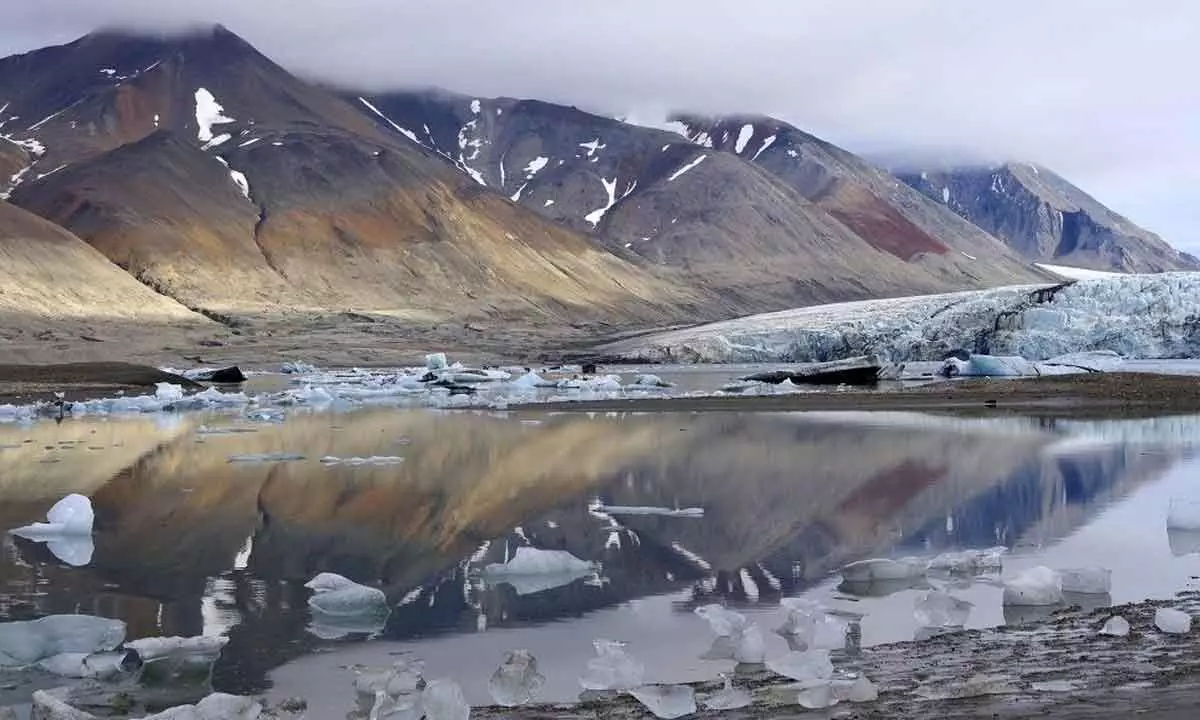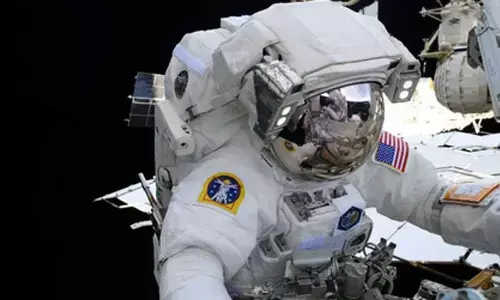The melting Arctic ice is a crime scene

When even modest quantities of this vast carbon store reach the atmosphere, warming accelerates – resulting in faster thawing of the tundra and the release of yet more greenhouse gases. Furthermore, not all greenhouse gases are equal in their impact. While carbon dioxide is relatively abundant and stable for centuries in the atmosphere, methane is less abundant and shorter-lived, but remarkably powerful as a greenhouse gas – nearly 30 times more damaging to the climate than carbon dioxide, for the same volume
The Arctic's climate is warming at least four times faster than the global average, causing irrevocable changes to this vast landscape and precarious ecosystem – from the anticipated extinction of polar bears to the appearance of killer whales in ever-greater numbers. A new study suggests the Arctic Ocean could be ice-free in summer as soon as the 2030s – around a decade earlier than previously predicted. But to properly understand the pace and force of what's to come, we should instead focus on organisms too small to be seen with the naked eye. These single-celled microbes are both the watchkeepers and arch-agitators of the Arctic's demise.
Scientists like me who study them have become forensic pathologists, processing crime scenes in our Arctic field sites. We don the same white anti-contamination suits, photograph each sampling site, and bag our samples for DNA analysis. In some areas, red-coloured microbes even create an effect known as “blood snow”. In this complex criminal investigation, however, the invisible witnesses are also responsible for the damage being done. Microbes testify to the vulnerability of their Arctic habitats to the changes that humans have caused. But they also create powerful climate feedback loops that are doing ever-more damage both to the Arctic, and the planet as a whole. Zipping headlong into icy oblivion My first visit to the Arctic was also nearly my last. As a PhD student in my early 20s in 2006, I had set out with colleagues to sample microbes growing on a glacier in the Norwegian archipelago of Svalbard – the planet's northernmost year-round settlement, about 760 miles from the North Pole.
The slightest change above freezing can transform an Arctic landscape from a frozen waste devoid of liquid water to one where microbes get busy reproducing in nutrient-rich water, transforming themselves in ways that further amplify the effects of climate warming. The Svalbard region is now warming seven times faster than the global average.
While much of the world continues its efforts to limit global warming to 1.5°C above pre-industrial levels, in the Arctic, that battle was lost long ago. Decades ahead of us all It's 2011, and Nozomu Takeuchi is visiting Svalbard from Japan. It has been a difficult year back home, following the earthquake, tsunami and Fukushima nuclear incident, but Nozomu – a glacier ecologist and professor at Chiba University – is unrelenting in his quest to measure the effects of climate change. Years ago, he made the link between the future of life and the death of ice, and these melting Svalbard glaciers are adding yet more points to his graphs. Just as we apply oodles of factor 50 to protect ourselves from the Sun, so the billions of microbes sandwiched between the sky and surface of the glacier protect themselves by accumulating sunscreen-like pigments. And if enough of these pigments rest in one place under the Sun, this area of “biological darkening” absorbs the heat of the Sun much more effectively than reflective white snow and ice – so it melts faster.
Open Google Earth and as you zoom in on the Arctic, you may spot the large dark stripe that scars the western margin of the Greenland ice sheet. This is the “dark zone”, but it's not caused by dark dust or soot. It's alive, laden with algae – and it has been darkening, and growing, as Greenland warms. Between 2000 and 2014, the dark zone's area grew by 14 per cent. At 279,075 km² in 2012, it was already more than twice the size of England than bare ice.
The glaciers are dying even as life blossoms on their darkening surfaces. Feedback processes such as biological darkening have the potential to multiply the number of drainage valves that are open, hastening dramatically the rate at which sea levels rise. To monitor this effect, every day Karen Cameron, the leader of our camp this summer, walks to undisturbed patches of ice carrying a £100,000 backpack which contains a spectrometer to measure the darkness of the ice, capturing how it absorbs the solar energy that causes melting. The glaciologists are desperate for ground truth, and their models need data. Up to this point, none of their predictions of how the Greenland ice sheet would respond to our warming climate have included biological darkening.
Even if the effect were modest, it could still topple the ice sheet from a predictable, straightline response to climate warming. All the time we are in Greenland, the only lifeforms we encounter are the flies that hatch from the fresh fruit and peppers in our food rations. These and the few types of glacier algae and several hundred kinds of bacteria that are biologically darkening the ice: a living scum scarring the surface of the ice sheet. My work focuses on how these tiny organisms adapt to their icy habitat, but the implications of their behaviour are now of global concern.
When even modest quantities of this vast carbon store reach the atmosphere, warming accelerates – resulting in faster thawing of the tundra and the release of yet more greenhouse gases. Furthermore, not all greenhouse gases are equal in their impact. While carbon dioxide is relatively abundant and stable for centuries in the atmosphere, methane is less abundant and shorter-lived, but remarkably powerful as a greenhouse gas – nearly 30 times more damaging to the climate than carbon dioxide, for the same volume. For more than three decades, Andy Hodson has worked at the frontier where microbes, carbon and the Arctic landscape meet. In 2018, we join him on a brisk spring day in Svalbard. It's -26°C but the snowmobile commute is thankfully brief – then we work quickly against the cold. Hodson's plan is to “pop” one of the many pingos that populate the floor of this wide open valley.
The earliest estimate of its ability to store carbon dioxide from the air on the ice surface of the world's glaciers exceeded Finland's total carbon emissions in the same year. Every cryoconite hole is a near-perfect ecosystem – with a singular flaw. Its inhabitants must melt ice to live. But the very act of melting the ice hastens the demise of their glacier habitat. Despite being found in some of the harshest locations on Earth, cryoconite is home for thousands of different types of bacteria (including the all-important photosynthetic cyanobacteria), fungi, and protozoa. Even tardigrades thrive in cryoconite. Its inhabitants are shielded and nourished at just the right depth and in the right shape for a busy ecosystem to be engineered by the interaction of sunlight with cyanobacteria, dust and ice to the benefit of all its inhabitants. The cyanobacteria use sunshine to capture carbon dioxide from the air and convert it into the slimy cement that builds each granule of cryoconite However, with vast numbers of cryoconite holes dotted across the ice surface, “swarms” of these holes help shape and darken the ice surface. This in turn influences the melting rate, as the surface is sculpted under the sun of 24-hour daylight.
Over the first fifth of this century, Earth's glaciers have discharged some ten quadrillion (ten to the power 25) tablespoons of melt a year – and within each tablespoon, the tens of thousands of bacteria and viruses that were once stored within that ice. What's to come is sadly predictable. Even the most modest warming scenario of 1.5°C above the pre-industrial era will lead to the extinction of at least half the Earth's 200,000 glaciers by the end of the century. Depending on the urgency and effectiveness of our actions as a civilisation, this century could also represent the “peak melt” in our history. Yet the battle to save many of these precious icy habitats is already lost. Instead, for scientists like me, our field work is now largely a question of documenting these “crime scenes” – so at least the knowledge of life within ice can be preserved, before it melts away forever.
(Writer is Reader in Biology, Department of Life Sciences, Aberystwyth University, Wales, UK)















